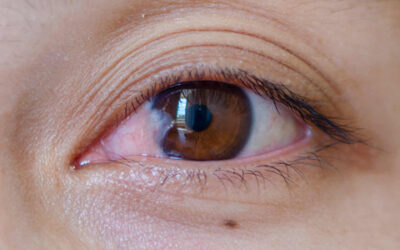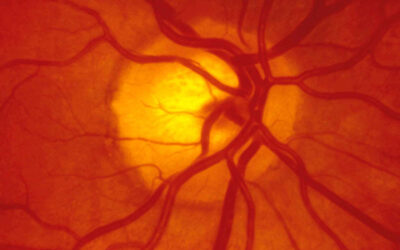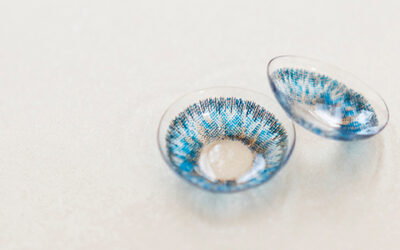Top Five Causes Of Red Eyes

Noticing that the whites of your eyes have turned red can feel concerning, and may leave you wondering what has caused the redness and if it’s an indication that there’s something serious going on. While most cases of red eyes will resolve on their own over time and cause no long-term damage,[1] knowing the cause can help you prevent red eyes from occurring in the first place while helping you know what you should do when they arise.
Since the majority of people we see have some eye redness at their appointments with our eye care professionals, here are five of the most common causes of red eyes we see, how to spot them, and how they’re treated.
1. Conjunctivitis
Conjunctivitis, otherwise known as pink eye, is the leading cause of eye infections across the country.[2] Conjunctivitis is an inflammation of a thin tissue layer in your eye called the conjunctiva that works to help keep your eyelid and eyeball moist. There are many small blood vessels in the conjunctiva, and when they become inflamed, they can cause redness in the eyes.
Symptoms may include: bloodshot eyes, itchiness, watery eyes, crusting eyelashes that stick together, a gritty feeling in the eyes, itchiness, burning, swelling, feeling like something is stuck in the eyes, sensitivity to light, and blurry vision.
Causes: The most common causes of conjunctivitis are viruses, bacteria, and allergens entering the eye, but other causes may include wearing contact lenses, air pollution, fungi, parasites, or simply having something small such as an eyelash stuck in the eye. In many cases, it can be difficult to tell what the exact cause of conjunctivitis is, because the symptoms may seem the same no matter the cause.
Treatment:
- Treatment for conjunctivitis depends on what is causing the condition, so seeing an eye care specialist plays an important role in diagnosing the cause so the right treatment steps can be taken.
- There is no single effective treatment for conjunctivitis; but artificial tears, antihistamine eye drops, cold-compresses, and removing whatever is irritating your eye can provide some relief at home.[3],[4]
- Many cases of conjunctivitis will resolve within 1-2 weeks, but we recommend making an appointment with an optometrist

2. Blepharitis
Blepharitis, otherwise known as inflammation of the eyelids, is an uncomfortable eye condition that can lead to red, swollen, and itchy eyes and eyelids. Your eyelids and eyelashes are designed to cover your eyes and protect them from debris and injury, and the hair follicles of your eyelashes contain oil glands to keep them soft and healthy.
Occasionally, these oil glands can become clogged or irritated, which can trigger blepharitis.
Symptoms may include: red, swollen, irritated, and itchy eyes and eyelids, crusty dandruff-like flakes on your eyelashes, feeling like there’s something in your eye, watery eyes, sensitivity to light, dry eyes, tears that are foamy or have small bubbles in them.
Causes: Most of the time, blepharitis happens because you have too much of a certain type of bacteria at the base of your eyelashes. You can also get blepharitis if the oil glands in your eyelids become clogged or irritated by makeup or an allergy, and you’re more likely to develop blepharitis if you also suffer from rosacea or dandruff on your scalp.
Treatment:
The best way to treat blepharitis is to keep your eyelids clean and free of crust. Using water and a clean cloth, wipe gently across your eyelids to remove crusts every day.
Applying a warm compress to your eyes can also reduce inflammation.
Usually, blepharitis doesn’t cause any lasting damage to your eye, but occasionally it can lead to other eye conditions. If your blepharitis is not going away, if it’s getting worse, or if you’re concerned, then we recommend booking an appointment with your optometrist, who can help your blepharitis to heal with targeted treatment, and prevent infection or complications.
3. Corneal Abrasion
A corneal abrasion is a small scratch to the surface of your cornea, a thin, transparent dome that covers the front layer of your eyeball. Your cornea is very delicate and sensitive and contains many nerve endings, which means that even a miniscule scratch can feel very uncomfortable and painful, and trigger eye redness.
Causes: Corneal abrasions can be caused by almost anything: tree branches, makeup brushes, workplace debris like specks of metal, sports equipment, an animal claw, and even sand, especially if you rub your eyes. Wearing damaged contact lenses or lenses for an extended period of time can also scratch your cornea.[6] This can happen at such a microscopic level, that many times, people don’t remember injuring their eyes at all.[7]
Symptoms may include: redness, pain, watery eyes, feeling like something large and rough is in your eye, rapid blinking, sensitivity to light, difficulty in opening your eye, and blurry vision.
Treatment:
- Most corneal abrasions are minor and heal quickly
- If you do scratch your eye or get something in your eye, rinse it thoroughly with clean water immediately, and blink a lot to try to remove any sand or other small objects from your eyes
- Don’t try to rub your eye, touch your eyeball, or put any other substances in your eye
- We recommend booking an appointment with your optometrist if you suspect you have a corneal abrasion, as they can use specialised equipment to check the size of the scratch, remove foreign materials, and check for signs of infection. They provide you with targeted treatment for pain relief and to prevent infection.
4. Dry Eyes
Dry eyes occur when you’re not producing enough tears to keep your eyeballs properly lubricated. It can also happen when one of your oil glands on the edge of your eye becomes clogged, meaning that your eyes aren’t producing enough oil, which can cause your tears to evaporate faster than normal and your eyes to become dry and red.
Symptoms may include: red eyes, and a scratchy feeling like there’s something in your eye. stinging or burning feelings in your eyes, sensitivity to light, blurry vision.
Causes: Many factors can cause dry eyes, such as the time spent staring at your phone or computer which reduces our blinking rate, exposure to smoke or dry air, wearing contact lenses, allergies, as part of the ageing process, or if you have certain autoimmune conditions, like lupus or Sjögren syndrome.
Treatment:
- Many people can find relief from dry eyes by applying warm compresses, which are proven to help your eyes to produce more tears as well as unclog blocked glands, releasing moisturising oils back into your eyelid.[8],[9]
- People who use computers for extended periods of time have been found to have a much higher rate of dry eyes[10] and other troublesome visual symptoms, such as eye strain, headaches, and blurred vision,[11] so cutting back on your screen time may help your eye dryness.
- Research has confirmed that taking omega-3 fatty acid supplements may significantly improve the uncomfortable symptoms of dry eyes.[12]
- If the air is particularly dry like in the winter months, consider using a humidifier to improve the air moisture at home, avoid sitting near air conditioners and fans if you can.
- Drink the required 8 glasses of water daily.

5. Subconjunctival Haemorrhage
A subconjunctival haemorrhage is a medical name for bleeding in your eyeball, causing one or more bright red spots to appear. This can look scary, but it’s usually harmless and often heals on its own. The eye’s conjunctiva is a thin tissue layer in your eye that works to help keep your eyelid and eyeball moist.
There are a lot of tiny blood vessels in the conjunctiva, and if they break, blood leaks between the conjunctiva and sclera – the white part of your eyeball. This bleeding is the bright red spot that you see on the white of your eye.
Causes: Subconjunctival haemorrhages are usually caused by coughing, sneezing, straining, heavy lifting, or other similar actions that briefly raise the blood pressure in your veins very quickly, causing the capillaries (tiny blood vessels) to break.
Occasionally a haemorrhage can also be caused by trauma such as something poking your eye, or even rubbing your eyes too hard. Rarely, they can be caused by diabetes, high blood pressure, other blood conditions, or medications such as aspirin.
Treatment: These blood spots in your eyes can look scary, but a subconjunctival haemorrhage is usually harmless and often heals on its own, as your eye cells regenerate and drain the blood away. Depending on how big your spot is, this may take a few days or a few weeks. However, we recommend making an appointment to see your optometrist for further investigation if:
- You think an eye injury or a flying object may have caused it
- You have bleeding in other parts of your body
- You get subconjunctival haemorrhages often
Is It Time To Visit An Eye Care Specialist?
At-home remedies can alleviate mild and temporary cases of red eyes, but if these strategies aren’t giving you relief, or if you’ve had an eye injury, headache, wear contact lenses, are in significant pain, or you’ve been struggling with red eyes for some time, we recommend booking an appointment with an optometrist.
Red eyes can have a range of causes, and they may be a symptom of a more serious underlying condition that needs medical care, such as glaucoma (an increase in pressure inside your eye) or a corneal ulcer (an ulcer on the cornea that can cause vision loss if not treated promptly).
Here at The Optical Co, our team is highly experienced in treating patients with a range of eye conditions and can carry out a range of comprehensive assessments to evaluate your eye health and determine the best strategies to find the long-term relief and comfort you need.
If red eye symptoms are bothering you, book an appointment at a clinic near you.
[1] https://www.ncbi.nlm.nih.gov/pmc/articles/PMC3017259/
[2] https://www.nps.org.au/australian-prescriber/articles/common-eye-infections
[3] https://www.ncbi.nlm.nih.gov/pubmed/30366797
[4] https://www.ncbi.nlm.nih.gov/pubmed/1928271
[5] https://www.ncbi.nlm.nih.gov/pubmed/10922425
[6] https://www.ncbi.nlm.nih.gov/pubmed/23317075
[7] https://www.ncbi.nlm.nih.gov/books/NBK532960/
[8] https://pubmed.ncbi.nlm.nih.gov/12695712/
[9] https://pubmed.ncbi.nlm.nih.gov/24270634/
[10] https://pubmed.ncbi.nlm.nih.gov/18708259/
[11] https://pubmed.ncbi.nlm.nih.gov/21480937/
[12] https://pubmed.ncbi.nlm.nih.gov/30702470/




